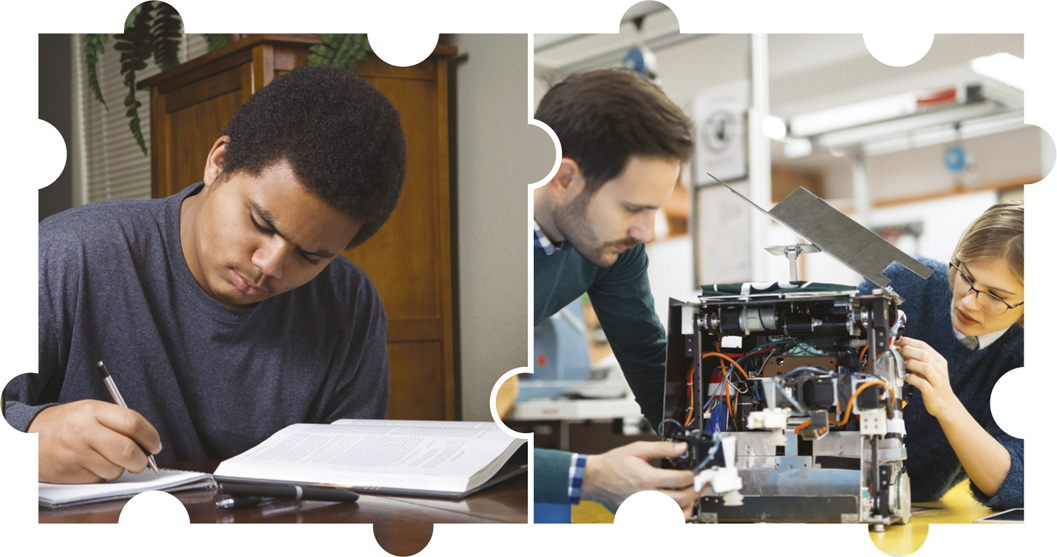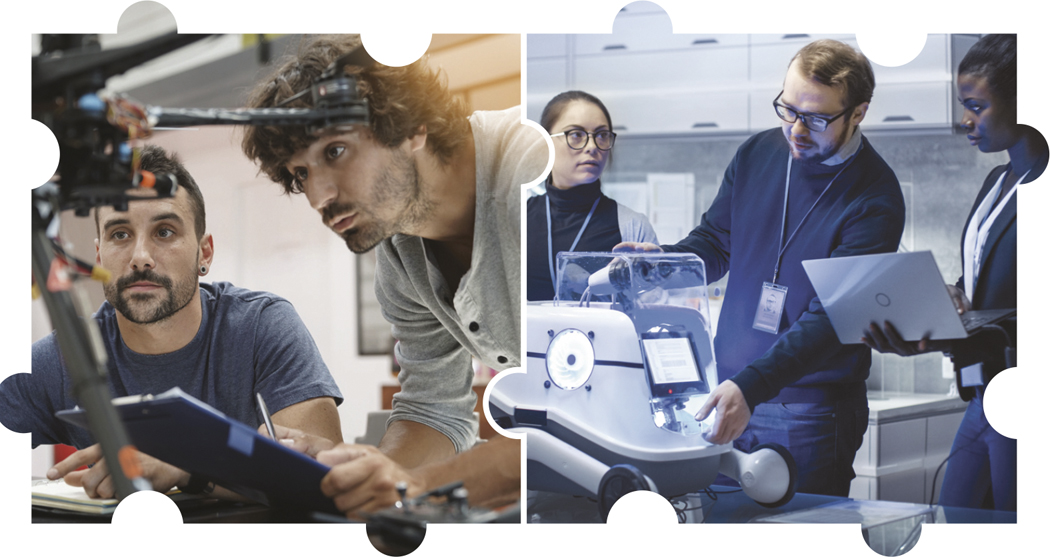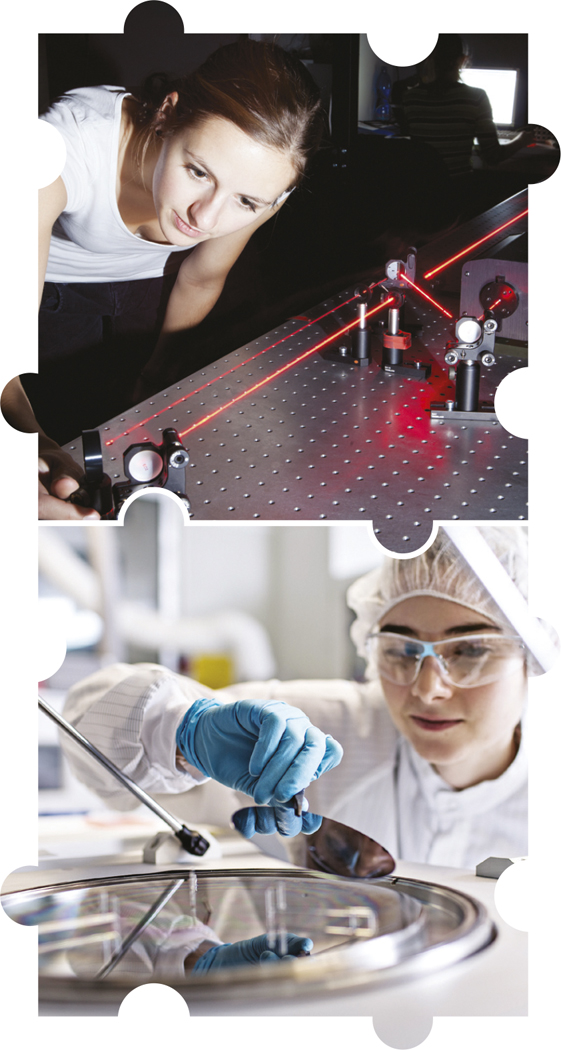Community colleges across the United States have important roles to play in identifying “men and women trained in science.” Many of the 1100 community colleges are actively involved in providing certificate, training, and terminal associate degree programs in advanced materials and advanced technology. Whether students are in materials-related technical education programs or are interested in pursuing an academic track, coupled with the fact that one in four undergraduate students in the United States is enrolled or co-enrolled at community colleges, the timing is right to formally develop and promote the incorporation of materials science concepts and research, and a discussion of career options. The ultimate success of these programs is dependent upon close collaborations with regional university faculty and departments that provide both opportunity and support for transferring community college students to continue to pursue their interests in one of the materials science and engineering (MSE) fields of study. MSE represents one of the exciting areas in which community college students can create new knowledge and push the boundaries of the “scientific frontier.”

Community colleges
Community colleges in the United States are open admission institutions that provide educational and workforce pathways for 40% of all undergraduate students. Students arrive at community colleges with diverse backgrounds, interests, and ages, yet a commonality is the search for areas of interest that transition into undergraduate degrees and subsequently into fulfilling careers. The introduction of MSE concepts at the community college level serves as a catalyst for transforming not only science and engineering education, but also for demonstrating the synergy of science and engineering with humanities and business education. MSE has the potential to significantly affect instructional strategies, outcomes, and impacts in generating a student population proficient in the integration of science, technology, engineering, mathematics, and computational science education.2–4 It is imperative for higher learning institutions to find students of talent and motivation and provide the transitional pathways and support that result in continued motivation, success, and innovation.
Identifying and preparing students for knowledge—materials science
Recent data (2015–2016) from the American Association of Community Colleges5 indicate that there are more than 12 million students who attend over 1100 community colleges within the United States. Approximately 7 million of these students seek associate degrees, certificates, and transfer to universities. Some of the reasons for students to attend or co-enroll in community colleges while attending local universities include:
▪ Significantly lower tuition costs as compared to most universities
▪ Availability of scholarships and other financial aid
▪ Location and travel logistics and constraints (work and home)
▪ Family issues, including parents returning to school
▪ Seeking a second chance at higher education
▪ Obtaining certifications to enhance their value in the workplace
▪ Seeking a change in careers, including those currently in the armed forces or returning to civilian life.
Approximately 7.2 million of these students are enrolled in credit programs, and about 5 million students are enrolled in noncredit programs. Of the ∼1100 community colleges, 982 are public, 36 are tribal, and 90 are classified as independent. Student data reflect that females represent 56% of the student population, Blacks and Hispanics represent 44%, White students about 48%, and Asians, Pacific Islanders and Native Americans combine to represent 7%.
The data also reveal that 36% of students are the first in their families to attend college, 17% are single parents, 4% are veterans, 7% are non-US citizens, and 7% have a prior bachelor’s degree. With regard to age distribution, 51% of students are younger than 21 years old, 39% range in age between 22 and 39, and 10% are older than 40. When taken as a percentage of the total US undergraduate student population, community college students represent 41% of all US undergraduates, 40% of freshmen (first year college students), 56% of Native Americans, 43% of Blacks, 52% of Hispanics, and 40% of Asian/Pacific Islanders.

Universities, business and industry (domestic and international), and government agencies have recognized the potential of this student population. Community colleges and universities have entered into partnerships to establish best practices and strategies for recruitment, retention, assessment, and career options for the general3,6,7 and underrepresented student populations.4,8,9 Corporations have developed similar strategies focused on recruitment and development of workplace skills and competencies,10–13 and agencies and departments within the US Department of Defense have discussed similar recruitment and educational strategies to satisfy current and projected personnel requirements.14–17 The inherent value of these reports lies within the commonalities and crossover of the recruitment, retention, and support strategies. While the strategies may have commonalities, the tactics for achieving those strategies tend to differ and offer significant insights based upon the perspective of the reader.
Numerous community colleges have developed materials-related programs across the United States. The National Science Foundation (NSF) Advanced Technological Education (ATE) national centers provide an example of the extensive nature of these programs.18 The mission of these centers is to develop innovative programs in areas such as materials, aerospace, advanced manufacturing, optics, cybersecurity, agriculture, communications, and micro- and nanotechnologies. In addition to these 42 national centers, ATE also funds several hundred projects19 that address regional workforce needs in partnership with local businesses, industry, and universities. ATE provides a well-established assessment and evaluation component to grantees, including effective project management, dissemination of information, and evaluation criteria.20
The development of programs in materials education and training, as illustrated through numerous regional and national workforce and educational initiatives, provides a foundation for other community colleges to study and emulate as they consider partnerships to participate in or initiate similar programs.
Materials science education at the community college level
In a National Research Council report,21 three panels discussed both tangible and intangible values of science education with undergraduate and graduate students majoring in non-science/engineering majors, with university faculty representing science, business, and the humanities, and with business professionals. The consensus from both undergraduate and graduate students who either did not enroll in science or math classes, or did not follow their interests in these areas, was a degree of regret. They did not recognize the future importance and value of these courses in making decisions about their education. Most faculty members mentioned that, in retrospect, a background in the sciences and mathematics was important whether one was majoring in journalism, economics, law, political science, sociology, or elementary education. Many of the faculty regretted “not taking a deeper dive” into science and math based upon the value that such a fundamental understanding of these concepts would have as they progressed through their careers.
Many students “declare” a major or career goal with minimal to no background information about their goals and the academic pathways required to achieve these career objectives. Community college students, whether entering higher education for the first time or returning to find a new career direction, may benefit from the information provided in a materials introductory course. Such a course could examine the interrelationships of materials science as seen in the context of disruptive technologies, history, cultural shifts and development, and impacts on society.
Fortunately, such a course has recently been developed: the Impact of Materials on Society.Reference Jones22 The objective of the course is to enable MSE students to obtain “the broad education necessary to understand the impact of engineering solutions in a global, economic, environmental, and societal context.” Kevin Jones at the University of Florida, in collaboration with the Materials Research Society (MRS), developed the course, which is presented in a module form. The course design aligns itself to be presented as a lower division science, engineering, or humanities course and is being offered at various US and international universities, community colleges, and to secondary school students, both domestically and internationally.
For many academic track community college students, their first introduction to materials science may be through participation in one of the many summer research experiences and internships provided by the NSF (Research Experiences for Undergraduates), the US Departments of Defense and Energy, and locally through internships with companies. These experiences often result in productive collaborations with community college faculty, civilian lab staff scientists, and commercial research scientists. Opportunities include internship programs, academic year or summer research programs, community college faculty introducing MSE concepts into lower division science and engineering coursework, and external funding to support current and new initiatives. An example of a well-established and nationally recognized outreach program that focuses on providing MSE research opportunities for community college students is the NSF Materials Research Science and Engineering Centers.23 The transformative impacts of these experiences on students and faculty have been demonstrated in recent reports4,24 that discuss strategies, challenges, successes, and opportunities for both students and faculty.

MSE continues to capture the imagination of students, faculty, teachers, politicians, and the community-at-large, whether discussing innovations in medicine and science based upon new applications of nanotechnology,25 how materials research has created new microgravity materials and applications at the International Space Station,26 or in conversations in Congress and state legislatures in dealing with the critical need to address the detrimental consequences of corrosion on the nation’s infrastructure.27,28
Partnerships
The NSF ATE program provides model examples of partnerships among higher education institutions, nonprofit organizations, and businesses. Each of the ATE centers has a distinct technical focus, and its products are dependent upon serving an established training and educational resource need; developing a highly educated, trainable, and motivated employee; and exploring new directions for collaborations.
At the 2017 MRS Fall Meeting held in Boston, a symposium focused on MSE education highlighted how partnerships with community colleges by regional universities, business and industry, state legislatures, and nonprofit organizations have resulted in the establishment of nationally recognized MSE programs.29
Both US and non-US speakers addressed the origins and impacts of collaborations including:
▪ The “disruptive factors,” merits, and challenges incurred in forming the stewardship of materials education partnerships and programs
▪ The interrelationship between academic track and technician track programs
▪ The ideas, significant events, mutual benefits, and cross-institutional perceptions that serve as precursors for creating partnerships, and comments on stewardship of the institutional and teacher/faculty partnerships
▪ Best practices developed and used to promote materials education across the K–16 educational continuum and beyond
▪ The value of educational collaborations and partnerships from business and industry perspectives.
The strategies and tactics of these partnerships reinforce many of the same found in the reports mentioned earlier. The education symposium stressed the importance of partnership development, stewardship, and the unique ability of community colleges to quickly respond to external requests for the creation of both academic and technical programs, based upon need and leveraging past and existing collaborations.
As demonstrated with the NSF ATE programs, development of materials science education at community colleges is dependent upon the establishment of a well-defined and participatory partnership. Community colleges being intermediaries between secondary school districts, universities, and the business community, and by leveraging their positions with state agencies and legislatures, are in a unique position to continue to provide nationally recognized and emulated academic track and technical workforce programs. These programs provide opportunities for incoming high-school students and current and returning community college students to explore academic and career options with materials professionals. Very few fields of study have the potential to stir one’s imagination quite like MSE.



